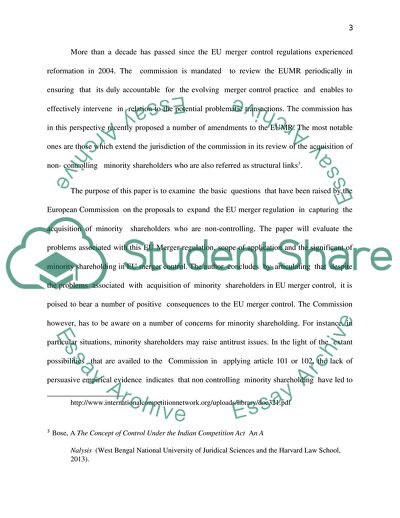
- Home
- Free Samples
- Premium Essays
- Editing Services
- Extra Tools
- Essay Writing Help
- About Us
- Studentshare
- Subjects
- Law
- Importance of Minority Shareholdings in EU Merger Control
Importance of Minority Shareholdings in EU Merger Control - Essay Example

- Subject: Law
- Type: Essay
- Level: Undergraduate
- Pages: 25 (6250 words)
- Downloads: 0
- Author: gkuvalis
Extract of sample "Importance of Minority Shareholdings in EU Merger Control"
An organization that harbors a small number of shareholders is regarded as a “close” or “closely held” corporation. A closely held corporation’s shareholders are normally divided into two groups a) those that have a controlling interest in a corporation, and (b) those that do not have a controlling interest and are hereby, referred to as minority shareholders. These categories of shareholders have to work harder in preserving their shareholder rights. Owing to the lack of a market for closely held shareholders shares that are held by minority shareholders are in essence illiquid. Further, minority shareholders who do not bargain beforehand for protective contractual arrangements may find that their minority interests are worth very low irrespective of the corporation or its assets1.
Established in 1989, the European Union of a Merger Control regime has been in existence for almost a quarter of a century and it is a well-established fact of life for business organizations that are involved in large-scale M and A. At that time, the European Commission (known as the commission resolutely secured for itself a place at the top table of the leading merger control authorities in many parts of the world2. More than a decade has passed since the EU merger control regulations experienced reformation in 2004.
The commission is mandated to review the EUMR periodically in ensuring that its duly accountable for the evolving merger control practice and enables effectively intervene in potentially problematic transactions. The commission has in this perspective recently proposed several amendments to the EUMR. The most notable ones are those which extend the jurisdiction of the commission in its review of the acquisition of non-controlling minority shareholders who are also referred to as structural links3.
The purpose of this paper is to examine the basic questions that have been raised by the European Commission on the proposals to expand the EU merger regulation in capturing the acquisition of non-controlling minority shareholders. The paper will evaluate the problems associated with this EU Merger regulation, the scope of application, and the significance of minority shareholding in EU merger control.
...Download file to see next pages Read MoreCHECK THESE SAMPLES OF Importance of Minority Shareholdings in EU Merger Control
Corporate Governance in Gulf Countries - Three Empirical Analysis
News Corp's Buyout of BSkyB
Takeovers Directive as a Piece of Legislation
The various exit strategies that investors may use and the implications for commercialization
Diversifications Effect on Firm Value: Mergers and Acquisitions
Why the Largest Takeover in Financial Services Industry Is Supposed as Worst Ever Made Deal
ICT and Regulation: The News Corp
The EUs 14th Company Directive

- TERMS & CONDITIONS
- PRIVACY POLICY
- COOKIES POLICY